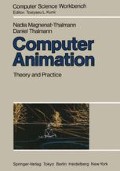Abstract
A three-dimensional line drawing is generally rather unrealistic, except in a few cases (see the Eiffel Tower in Fig. 7.1). To achieve realism in a computer-generated image, lines which could not really be seen by an observer first must be removed. This process has been a common research theme since the first three-dimensional Systems; numerous algorithms have been proposed to solve the problem [Sutherland et al, 1974]. They can be classified into three major categories.
Access this chapter
Tax calculation will be finalised at checkout
Purchases are for personal use only
Preview
Unable to display preview. Download preview PDF.
Author information
Authors and Affiliations
Rights and permissions
Copyright information
© 1985 Springer- Verlag Tokyo
About this chapter
Cite this chapter
Magnenat-Thalmann, N., Thalmann, D. (1985). Hidden Surfaces, Reflectance and Shading. In: Computer Animation. Computer Science Workbench. Springer, Tokyo. https://doi.org/10.1007/978-4-431-68433-6_7
Download citation
DOI: https://doi.org/10.1007/978-4-431-68433-6_7
Publisher Name: Springer, Tokyo
Print ISBN: 978-4-431-68435-0
Online ISBN: 978-4-431-68433-6
eBook Packages: Springer Book Archive

